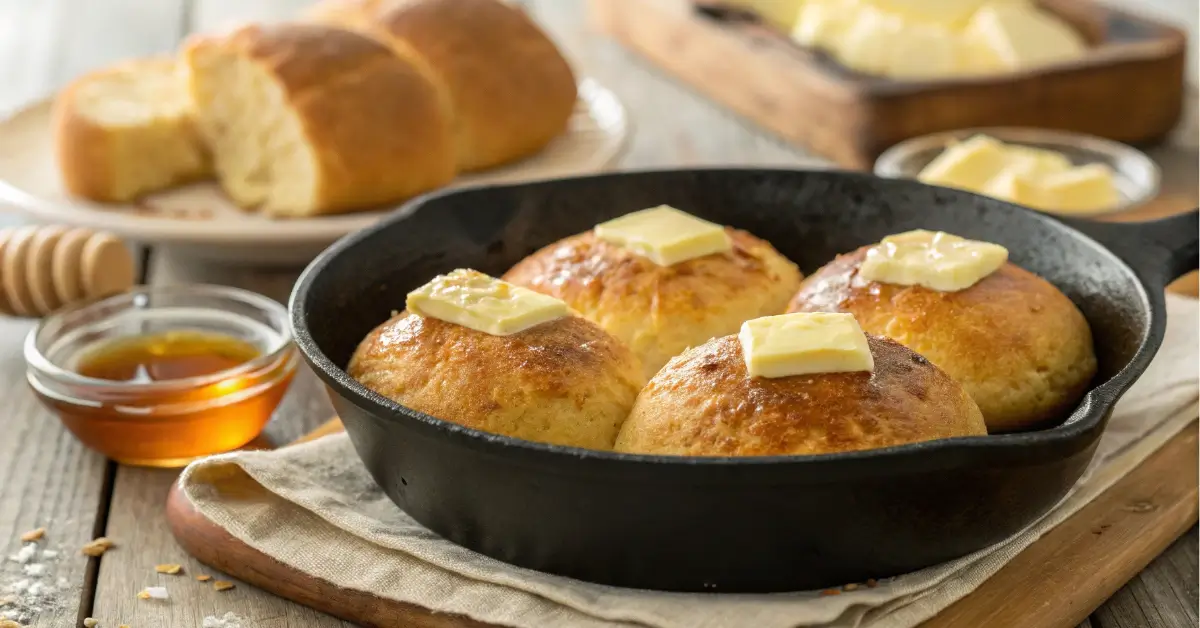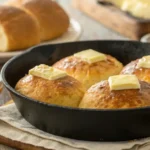Few dishes represent old-school Southern comfort like hoe cake bread. Known for its crispy edges and soft, cornbread-like center, this humble skillet-baked staple is steeped in history and flavor. From plantation fields to presidential breakfasts, hoe cake bread has stood the test of time and earned its place at the table of American food culture. In this in-depth guide, we’ll explore its origins, differences from similar dishes like pancakes and cornbread, how to make it just right, and even what flour to use for the fluffiest results.
Discover great ideas like our Easy Salisbury Steak Recipe that pairs wonderfully with hoe cake bread for a heartwarming Southern meal.
Jump to:
The History and Origins of Hoe Cake Bread
The Roots of Hoe Cake Bread in American Southern Cuisine
The story of hoe cake bread begins with early American settlers and enslaved Africans in the Southern colonies. Originally made from a simple mix of cornmeal, salt, and water, these cornmeal flatbreads were cooked over open flames—often on the flat side of a gardening hoe, hence the name.
In fact, during the 1700s and 1800s, hoe cakes weren’t just a meal; they were a way of life. The limited access to ovens made skillet and open-fire cooking the norm for working-class and enslaved families. Hoe cakes, due to their simplicity and heartiness, quickly became a staple of survival and tradition.
These early versions of hoe cake bread weren’t sweet or soft—they were rugged, rustic, and made with gritty stone-ground cornmeal, reflecting the resilience of the people who made them. Over time, the recipe evolved, integrating ingredients like buttermilk, eggs, or baking soda, depending on region and resources.
How Enslaved African Americans Contributed to the Recipe’s Legacy
While hoe cake bread might appear as just another Southern dish today, its historical roots run deep. Enslaved African Americans were central to its popularization. These resourceful cooks often used cast-iron pans or the backs of shovels heated over open flames to make hoe cakes while working long hours in the fields.
These traditions laid the groundwork for what we now celebrate as Southern cuisine, and hoe cake bread remains a powerful symbol of that culinary heritage.
Don’t miss our Johnny Cakes guide for another historic flatbread cousin of the hoe cake, rooted in early American culture.
Want more comforting recipes with heritage vibes? Check out our Banana Cake Mix recipe—a modern twist on a classic pantry staple.
Explore dishes with deep American roots like our Chicken and Dressing Recipe—another traditional Southern staple perfect alongside hoe cake bread.
What Makes Hoe Cake Bread Unique?
Key Differences Between Hoe Cake Bread and Traditional Cornbread
At first glance, hoe cake bread might seem like just a flat version of cornbread. But there’s more than meets the eye. Both are made with cornmeal, but the preparation method and texture set them apart.
Cornbread is usually baked in an oven and results in a thick, fluffy loaf or squares. It often contains flour, eggs, buttermilk, baking soda, and sometimes sugar. In contrast, hoe cake bread is pan-fried on a hot surface—preferably a cast-iron skillet—creating a crisp, golden crust with a thinner, more rustic bite.
Another key point: hoe cakes are quicker to cook, making them ideal for stovetop prep when ovens weren’t available. This made them a go-to dish for field workers, homesteaders, and anyone craving a fast, satisfying carb without the fuss of baking.
You’ll also find hoe cakes more adaptable to savory meals. They can act as a bread side or base for toppings like pulled pork, collard greens, or even maple-drizzled fried chicken.
Looking for inspiration? Try our Smoked Salmon Temperature Guide to pair your hoe cakes with something smoky and satisfying.
Texture, Ingredients, and Flavor Profile Breakdown
The signature trait of hoe cake bread lies in its texture. While cornbread can sometimes turn out dry or crumbly, a well-made hoe cake has:
- A crispy, golden-brown outer crust
- A tender, slightly chewy center
- Just the right amount of cornmeal grit
Ingredient-wise, hoe cake recipes often skip the flour or limit it to just a spoonful, keeping the corn flavor front and center. In traditional versions, all you need is:
| Ingredient | Purpose |
|---|---|
| Cornmeal | Main base, gives grainy texture |
| Salt | Enhances flavor |
| Water or Buttermilk | Moisture and tang |
| Oil or Lard | Crisp frying and richness |
Modern updates may add a bit of sugar, baking powder, or eggs, but even then, hoe cakes maintain their distinctly rustic character.
Unlike sweet cake bread or fluffy pancakes, hoe cake bread leans more toward savory satisfaction. That makes it a reliable sidekick to anything from beans to fried catfish.
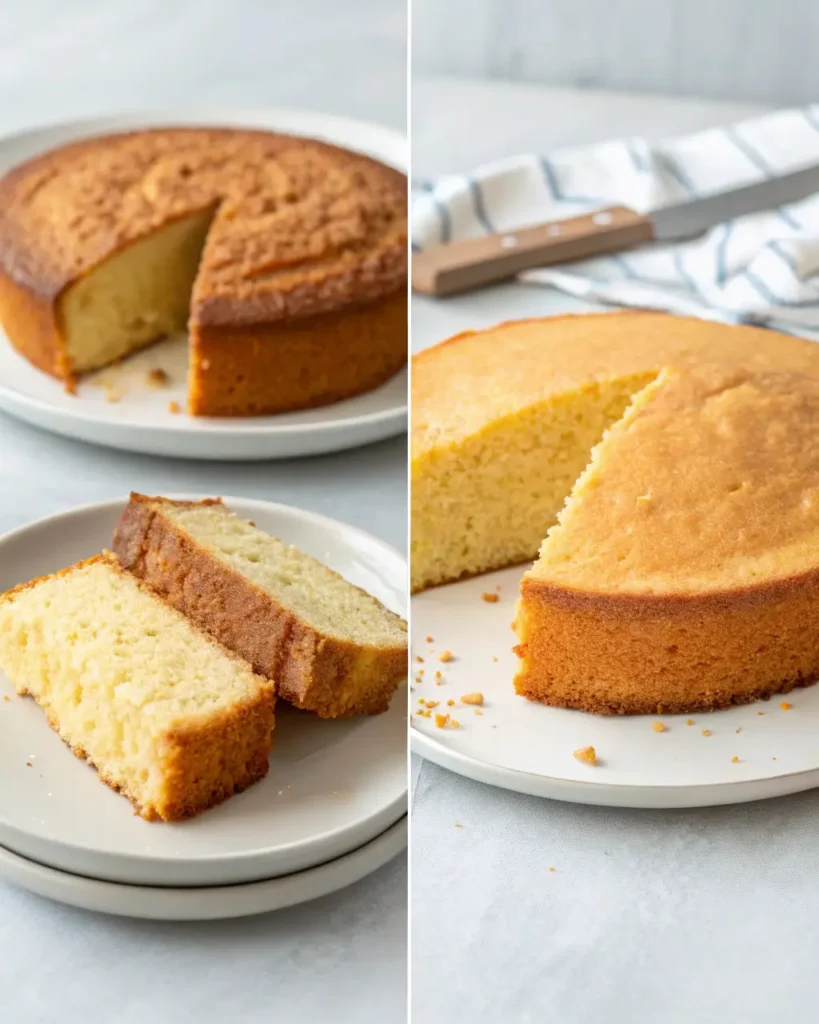
Check out our Protein Donuts if you’re exploring other flour-based recipes with a modern health twist.
The Ingredients That Define a Perfect Hoe Cake Bread
Essential Pantry Staples for Authentic Hoe Cakes
Creating the perfect hoe cake bread doesn’t require fancy ingredients—it’s all about simplicity and balance. The traditional Southern hoe cake relies on a few core pantry staples, but getting them right makes all the difference.
Here’s what you’ll need for a classic version:
- Cornmeal – The backbone of hoe cake bread. Use medium or coarse grind for texture. Avoid overly fine cornmeal—it won’t yield that signature crispy crust.
- Salt – Just a pinch enhances the cornmeal’s natural flavor.
- Water or Buttermilk – Water keeps it rustic and basic. Buttermilk adds tanginess and a creamier finish.
- Oil, Bacon Grease, or Lard – Essential for frying. A hot cast iron skillet with a slick of grease creates the golden, crunchy edge hoe cake bread is famous for.
Optional but traditional enhancements include:
- Eggs – Help bind and add a fluffier interior.
- Flour – Some recipes call for a spoonful to soften the texture.
- Baking Powder – Adds lift and prevents denseness.
- Sugar – A Southern twist that some families love; others consider it sacrilege.
Here’s a quick visual cheat sheet:
| Ingredient | Traditional Version | Modern Twist |
|---|---|---|
| Cornmeal | Coarse yellow | Fine white or blue |
| Liquid Base | Water | Buttermilk |
| Fat | Lard/Bacon Grease | Olive Oil/Butter |
| Add-ins | None | Egg, sugar, flour |
Check out our Almond Flour Crepes for a flour-based recipe that swaps tradition for innovation.
Choosing the Right Cornmeal and Flour for Best Results
One of the biggest mistakes when making hoe cake bread is choosing the wrong type of cornmeal. A fine grind will leave your cakes soft and soggy, while coarse meal delivers that hearty, crackly bite we’re after.
When choosing cornmeal:
- Stone-ground cornmeal is ideal for flavor and texture.
- Avoid self-rising cornmeal mix unless the recipe calls for it.
Wondering about flour? While traditional hoe cakes skip it, adding cake flour can soften the center. Cake flour is lower in protein, which means less gluten and a lighter texture. But be careful—too much, and you’ll lose the gritty integrity that defines hoe cake bread.
If you’re gluten-sensitive, try blending cornmeal with rice flour or almond flour for similar texture without the wheat.
Discover great ideas like our Keto Pies with Apple to see how flour alternatives work in other recipes.
Step-by-Step Guide to Making Classic Hoe Cake Bread
Detailed Recipe with Tips for Getting the Texture Right
Making hoe cake bread is refreshingly simple—no oven, no mixer, no problem. You’ll only need a hot skillet, a handful of ingredients, and about 10 minutes. Follow this time-tested method and you’ll have golden, crispy hoe cakes ready to serve in no time.
Ingredients (makes 6-8 small hoe cakes):
- 1 cup coarse cornmeal
- 1/2 teaspoon salt
- 3/4 cup boiling water (or buttermilk for creamier texture)
- 2 tablespoons bacon grease or vegetable oil (plus more for frying)
- Optional: 1 egg, 1 teaspoon baking powder for a fluffier version
Instructions:
- Preheat Your Skillet
Use a cast iron pan for best results. Heat over medium until hot—test with a drop of water; it should sizzle immediately. - Mix the Batter
In a medium bowl, combine cornmeal and salt. Slowly stir in the boiling water (or buttermilk) until you get a thick, sticky batter. Add egg or baking powder now if using. - Add Grease
Stir in the bacon grease or oil. This helps with binding and gives the batter richness. - Fry to Golden Perfection
Add a thin layer of oil to the hot skillet. Scoop batter by large spoonfuls into the pan and flatten slightly. Fry 2–3 minutes per side or until crisp and brown. - Drain and Serve
Remove hoe cakes with a spatula and let them drain on paper towels. Serve hot with butter, honey, or alongside savory dishes.
💡 Pro Tip: Don’t overcrowd the pan—give each cake room to crisp up! A too-crowded skillet results in steaming, not frying.
Don’t miss our How to Make Chimichangas for another skillet-based favorite that’s bold, crispy, and satisfying.
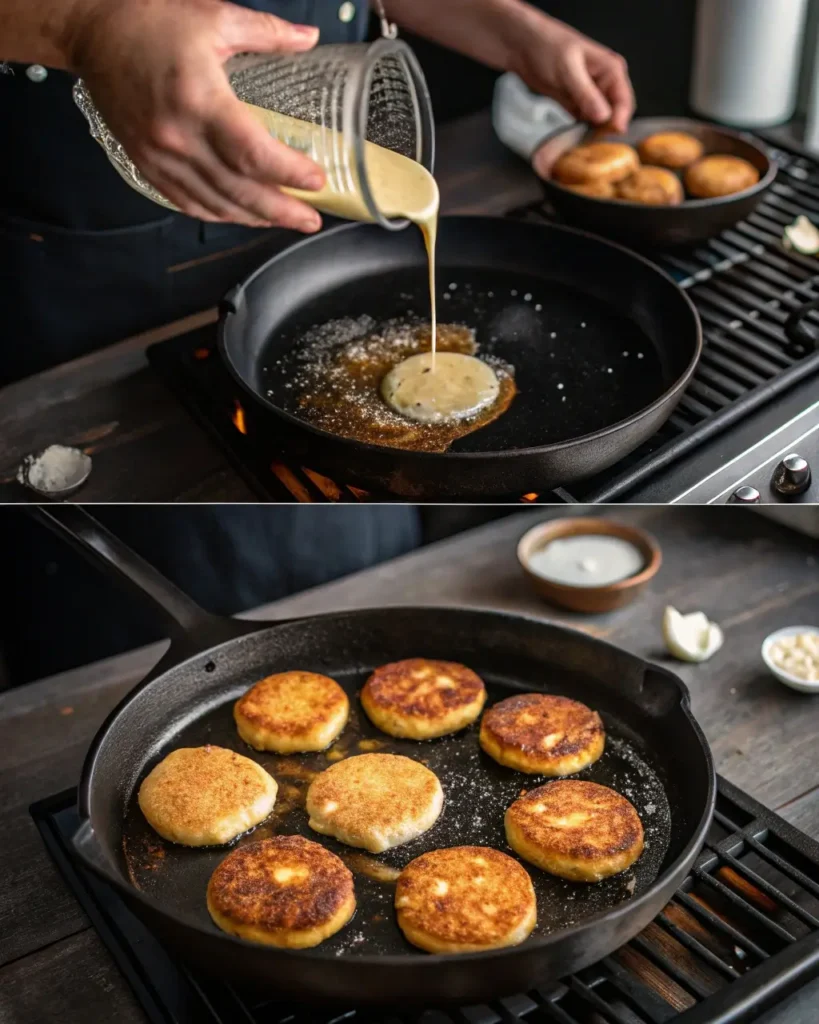
Mistakes to Avoid When Cooking Hoe Cake Bread
Even the simplest recipes can go sideways without attention to technique. Here are a few common mistakes to steer clear of when making hoe cake bread:
- Using too much liquid: Results in runny batter that won’t crisp properly. The batter should hold its shape when spooned into the skillet.
- Cold skillet: If your pan isn’t hot enough, your hoe cakes will soak up oil and turn greasy instead of golden.
- Flipping too soon: Wait until you see crispy edges before turning. Premature flipping breaks the crust and leaves the center undercooked.
- Overcrowding: Fry in batches to ensure even cooking and a perfect crust every time.
Looking for another quick stovetop dish? Explore our Salmon Bowl Recipe for a nourishing meal that complements hoe cakes beautifully.
Variations and Regional Twists on Hoe Cake Bread
Southern, Appalachian, and Creole Interpretations
Across the Southern United States, hoe cake bread is more than just a flat cornmeal patty—it’s a canvas for culture, history, and regional pride. Each area has added its own spin to this rustic favorite, creating a wide range of flavor and texture experiences.
Let’s break it down:
- Deep South (Georgia, Alabama, Mississippi)
In this region, hoe cake bread is often a skillet-fried delicacy made with bacon grease and served alongside collard greens, black-eyed peas, or fried catfish. Sometimes, a pinch of sugar is added for a lightly sweet contrast. - Appalachian Mountains
Here, hoe cakes are thicker, almost like rustic pancakes. They may include flour or baking powder, offering a lighter interior. Many mountain cooks fry them in lard for a rich, old-fashioned flavor. - Creole and Cajun Louisiana
In Creole kitchens, hoe cake bread may be topped with étouffée or gravy. Cajun versions sometimes feature garlic or even chopped shrimp right in the batter. - Caribbean Johnny Cakes Connection
While not exactly the same, Caribbean johnny cakes are close cousins to hoe cakes, often sweetened slightly and fried for breakfast.
These local variations reflect the dish’s flexibility. No matter where you’re from—or what ingredients you have—hoe cake bread can be adapted to suit your taste.
Learn more about similar recipes with our Johnnycake recipe and explore its ties to hoe cake history.
Vegan, Gluten-Free, and Skillet-Baked Alternatives
Today’s home cooks love hoe cakes just as much—but often seek versions that fit specific dietary needs. Luckily, it’s easy to customize hoe cake bread without sacrificing texture or flavor.
Here’s how:
Vegan Hoe Cake Bread:
- Swap eggs for flax or chia egg replacements
- Use plant-based milk instead of buttermilk
- Fry in avocado oil or vegan butter
Gluten-Free Hoe Cake Bread:
- Stick with 100% cornmeal (no added flour)
- Or blend cornmeal with almond flour or rice flour
- Ensure cornmeal is labeled gluten-free (some brands process with wheat)
Baked Hoe Cake Option:
Want to cut the oil? Try baking hoe cake batter in a preheated cast iron skillet in the oven (425°F for 15–20 minutes). It turns out a thicker, crumblier hoe cake that resembles skillet cornbread but keeps that iconic crispy edge if the skillet is hot enough.
| Version | Key Substitution | Notes |
|---|---|---|
| Vegan | Flax egg, almond milk | Fry in oil or plant butter |
| Gluten-Free | Almond/rice flour mix | Watch for cornmeal cross-contam |
| Skillet-Baked | Oven method (425°F) | Great for batch cooking |
Looking for inspiration? Try our Coconut Clusters—a sweet treat that pairs well with savory hoe cake meals for a balance of flavor and texture.
Serving Ideas: What Goes Best With Hoe Cake Bread?
Pairing Hoe Cakes With Savory Dishes Like Greens and Gravy
Hoe cake bread might be simple in ingredients, but it’s endlessly versatile on the plate. In Southern homes, hoe cakes are more than just bread—they’re a vehicle for flavor, texture, and soul food satisfaction. Here’s how to pair them like a pro.
Classic Southern Combinations:
- Collard greens + hoe cake bread – Soak up that rich pot liquor with each bite.
- Fried catfish + hoe cakes – Skip the hushpuppies. This is the real match.
- Sausage gravy over hoe cakes – A hearty breakfast that sticks with you all day.
- Red beans or black-eyed peas – Serve hoe cakes on the side or under the bowl to catch every last drop.
These combos honor hoe cake bread’s savory roots and enhance its slightly gritty texture with complementary flavors.
Discover great ideas like our Easy Chicken Thighs and Hominy Casserole for a bold, Southern-style pairing that brings out the best in every bite.
Looking to elevate your brunch game? Top hoe cakes with creamy scrambled eggs, crisp bacon, and a drizzle of hot sauce for a no-fuss, crowd-pleasing platter.
Turning Hoe Cakes Into Sweet Treats With Honey or Syrup
While hoe cake bread is typically savory, it can easily take a turn into sweet territory with just a few toppings.
Sweet Serving Suggestions:
- Butter + honey drizzle – Simple, classic, irresistible.
- Maple syrup + whipped cream – Like pancakes, but with more texture.
- Fruit preserves – Strawberry, fig, or peach jam turns your hoe cake into a Southern breakfast favorite.
- Cinnamon sugar dusting – Great for kids or dessert lovers.
Think of it like this: if it works on a pancake or biscuit, it probably works on hoe cake bread too.
| Savory Pairings | Sweet Toppings |
|---|---|
| Sausage gravy | Honey + butter |
| Collard greens | Maple syrup |
| Pulled pork or brisket | Fruit preserves |
| Fried chicken or eggs | Cinnamon sugar |
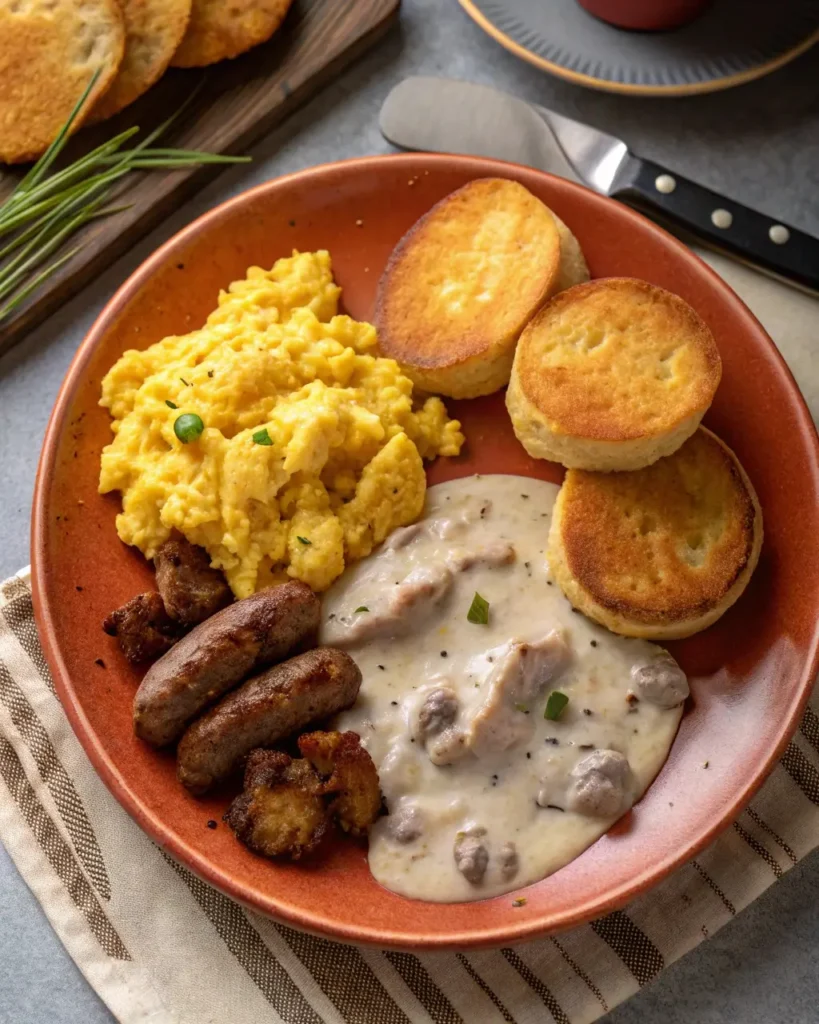
Looking for a unique sweet combo? Don’t miss our Banana Pudding with Chessman Cookies—it’s a creamy, Southern dessert that finishes your hoe cake meal in style.
Hoe Cakes vs Pancakes: The Surprising Differences
Comparing Ingredients, Cooking Methods, and Uses
It’s a common question: is hoe cake bread just a Southern pancake in disguise? The short answer—nope. While they may share a skillet, they couldn’t be more different in ingredients, flavor, and purpose.
Let’s compare:
| Feature | Hoe Cake Bread | Pancakes |
|---|---|---|
| Main Base | Cornmeal | All-purpose flour |
| Texture | Gritty, crispy edges | Soft, fluffy, cake-like |
| Flavor Profile | Slightly savory, corn-forward | Mildly sweet |
| Liquid Used | Water or buttermilk | Milk or buttermilk |
| Use Case | Side dish for savory meals | Main dish for breakfast with syrup |
Hoe cake bread brings a rustic, hearty crunch and works best as a side—something to scoop up gravy, cradle a fried egg, or accompany smoky greens. Pancakes are fluffier, sugary, and meant to be eaten sweet with toppings like syrup and fruit.
Don’t miss our Crepe Cake recipe if you’re craving a more delicate flour-based alternative to traditional pancakes.
Why Hoe Cake Bread Is Not Just a Southern Pancake
The confusion usually comes from appearance. Hoe cakes are flat, pan-fried, and round—just like pancakes. But while pancakes rise from flour, eggs, and baking powder, hoe cake bread often skips the fluff. It leans into its cornmeal grit and skillet sear.
In essence:
- Pancakes = breakfast centerpiece
- Hoe cakes = meal support side
And unlike pancakes, hoe cake bread carries the weight of Southern tradition. It wasn’t made to be sweet and fluffy—it was made to be practical, hearty, and flavorful.
So next time someone tries to call hoe cake bread a pancake, you’ll know it’s so much more.
Explore more comforting dishes like our Hamburger Potato Soup—a warm, hearty main that pairs perfectly with a crisp-edged hoe cake.
Hoe Cake Bread Through History: George Washington’s Breakfast
Historical Mentions of Hoe Cakes in Early America
Hoe cake bread isn’t just a Southern comfort food—it’s a piece of American history. These cornmeal cakes date back to colonial times, when they were known for their practicality, affordability, and ease of preparation.
In the 18th century, hoe cakes were commonly eaten by settlers, farmers, and enslaved communities across the South. With limited access to ovens, the hoe cake—fried on a flat metal surface over an open flame—offered a quick, filling bread option. Often cooked with lard or drippings and eaten hot off the skillet, they were as essential to rural cooking as cast iron.
They were also versatile—served plain, with gravy, or even topped with syrup if available. But what really made hoe cake bread famous?
George Washington.
Famous Fans Like George Washington and Their Preferences
Yes, the first U.S. president was a dedicated hoe cake eater. According to historical accounts from Mount Vernon, George Washington’s favorite breakfast included hoe cakes “swimming in butter and honey.” He reportedly enjoyed them almost daily, accompanied by hot tea.
His enslaved chef, Hercules, was known for preparing hoe cakes for the presidential table—both at Mount Vernon and later in Philadelphia. Washington’s fondness for this cornmeal-based bread helped cement its place as a respected staple in American cuisine, not just a working-class food.
The mention of hoe cakes in historical documents adds not only charm, but credibility to their role in shaping early American culinary identity. They weren’t just for the field—they made it to the dining room of the president himself.
Looking for more old-fashioned breakfast ideas? Don’t miss our 3-Ingredient Banana Bread—a recipe with simplicity and legacy baked in.
Hoe cake bread has always been about more than just sustenance. It’s about resourcefulness, tradition, and yes—even a presidential endorsement.
Flour Talk: Cake Bread vs Regular Flour Explained
How Cake Flour Changes Texture Compared to All-Purpose Flour
While traditional hoe cake bread relies mainly on cornmeal, some modern or regional recipes call for the addition of flour—usually in small amounts—to improve texture. But what kind of flour should you use?
Let’s look at the two most common options:
Cake Flour:
- Low protein (6-8%)
- Very fine texture
- Absorbs less water
- Results in soft, tender, almost melt-in-your-mouth baked goods
All-Purpose Flour:
- Moderate protein (10-12%)
- Coarser than cake flour
- Offers more structure and chew
- Delivers a firmer, denser bite in breads and cakes
In the context of hoe cake bread, adding cake flour to the batter (just a tablespoon or two) can soften the inner crumb without sacrificing crisp edges. It helps prevent the cakes from becoming too dry, especially when using coarse cornmeal.
On the other hand, using all-purpose flour adds more body and chew, making your hoe cakes feel more like a cross between cornbread and flatbread.
| Flour Type | Texture Impact on Hoe Cakes | When to Use |
|---|---|---|
| Cake Flour | Softens interior, delicate bite | For brunch or sweeter hoe cake styles |
| All-Purpose | Denser, heartier chew | For savory meals or skillet baking |
Don’t miss our Cake Mix Banana Bread to see how different flours affect texture and moisture across bread recipes.
When to Use Each for Baking Perfection
The choice between cake flour and all-purpose flour depends on your goal:
- Want your hoe cake bread to be light and dessert-like? Use a touch of cake flour.
- Want a heartier base for savory pairings like chili or fried chicken? Stick with all-purpose or leave the flour out entirely for a crispier result.
Ultimately, your flour choice is one of the easiest ways to personalize your hoe cakes. Just remember—not all flour is created equal, and even a small adjustment can change the outcome dramatically.
Looking for another flour-based comfort food? Explore our Cheesy Chicken Sloppy Joe Recipes to see how structure, flavor, and binding ingredients come together in savory bites.
Frequently Asked Questions About Hoe Cake Bread
What is hoe cake bread?
Hoe cake bread is a traditional Southern flatbread made primarily from cornmeal, salt, and water (or buttermilk), then pan-fried in a skillet until crisp and golden. It’s thinner than cornbread, with a gritty texture and a rustic, savory flavor. Unlike baked breads, it’s cooked directly on a hot surface, giving it its signature crunchy edges and soft center.
Why are they called hoecakes?
The term “hoecakes” comes from the historical method of cooking them on a hoe over an open fire. Enslaved people and early settlers used flat, metal hoes (the gardening tool) as makeshift griddles, hence the name. Over time, “hoe cakes” evolved into a regional term for skillet-fried cornmeal cakes.
What is the difference between cornbread and hoecakes?
The key difference is in preparation and texture. Cornbread is baked and often fluffier, while hoe cake bread is pan-fried and thinner with crispy edges. Cornbread may include flour, eggs, and leavening agents, while hoecakes traditionally rely on just cornmeal, water, and fat. The flavor of hoecakes is typically more savory and straightforward.
What is the difference between hoecakes and pancakes?
While hoecakes and pancakes are both griddle-cooked, their ingredients and texture are quite different. Pancakes are made with flour, eggs, and baking powder, resulting in a soft, sweet breakfast dish. Hoe cake bread, on the other hand, is made with cornmeal and is much crispier, denser, and generally served as a side with savory meals.
What did George Washington eat for breakfast?
According to records from Mount Vernon, George Washington frequently ate hoe cake bread for breakfast, often served “swimming in butter and honey.” His household cook, Hercules, prepared them fresh in a skillet. This simple dish was one of his favorites and a staple of the 18th-century American table.
What’s the difference between cake bread and regular flour?
Cake flour is more finely milled and lower in protein than all-purpose (regular) flour. It creates a tender, soft crumb in baked goods. When used in hoe cake bread, cake flour can slightly lighten the texture. Regular flour adds more density and chew, which may be preferable for savory applications.
Conclusion
From iron skillets and plantation fields to George Washington’s breakfast table, hoe cake bread holds its place as a timeless symbol of Southern resilience and flavor. It’s more than just a rustic cornmeal cake—it’s a cultural bridge between generations of cooks who made magic with what little they had.
Whether you like them crisp and savory or fluffy with honey drizzle, hoe cakes offer infinite ways to enjoy an old-school favorite. With regional spins, dietary-friendly versions, and simple ingredients you likely already have, there’s no reason not to try this soulful classic at home.
Looking for more easy Southern staples? Check out our Chicken and Dressing or discover the magic of Banana Cake Mix ideas to keep the nostalgic comfort going strong.
PrintTraditional Southern Hoe Cake Bread
A crispy, pan-fried cornmeal flatbread with deep Southern roots—hoe cake bread is quick, rustic, and packed with history. Perfect as a savory side or sweet breakfast base.
- Prep Time: 5 minutes
- Cook Time: 10 minutes
- Total Time: 15 minutes
- Yield: 6–8 hoe cakes
- Category: Side Dish, Bread
- Method: Frying
- Cuisine: Southern, American
- Diet: Vegetarian
Ingredients
- 1 cup coarse yellow cornmeal
- 1/2 teaspoon salt
- 3/4 cup boiling water (or buttermilk for creamier texture)
- 2 tablespoons bacon grease or vegetable oil (plus more for frying)
Optional:
- 1 large egg
- 1 teaspoon baking powder
Instructions
- Preheat a cast iron skillet over medium-high heat until hot.
- In a bowl, combine cornmeal and salt.
- Slowly stir in boiling water (or buttermilk) until the batter is thick and scoopable.
- Mix in the grease or oil. If using, add egg and baking powder now.
- Lightly oil the skillet and spoon in batter, flattening each scoop slightly.
- Fry for 2–3 minutes per side, or until golden brown and crispy.
- Remove and drain on paper towels. Serve warm.
Notes
- For a vegan version, use plant-based milk and oil; skip the egg or use flax egg.
- For gluten-free hoe cakes, avoid added flour or use gluten-free alternatives like almond flour.
- Buttermilk gives a richer, slightly tangy flavor, but water works fine for a more rustic version.
- Best served immediately for crispness.

